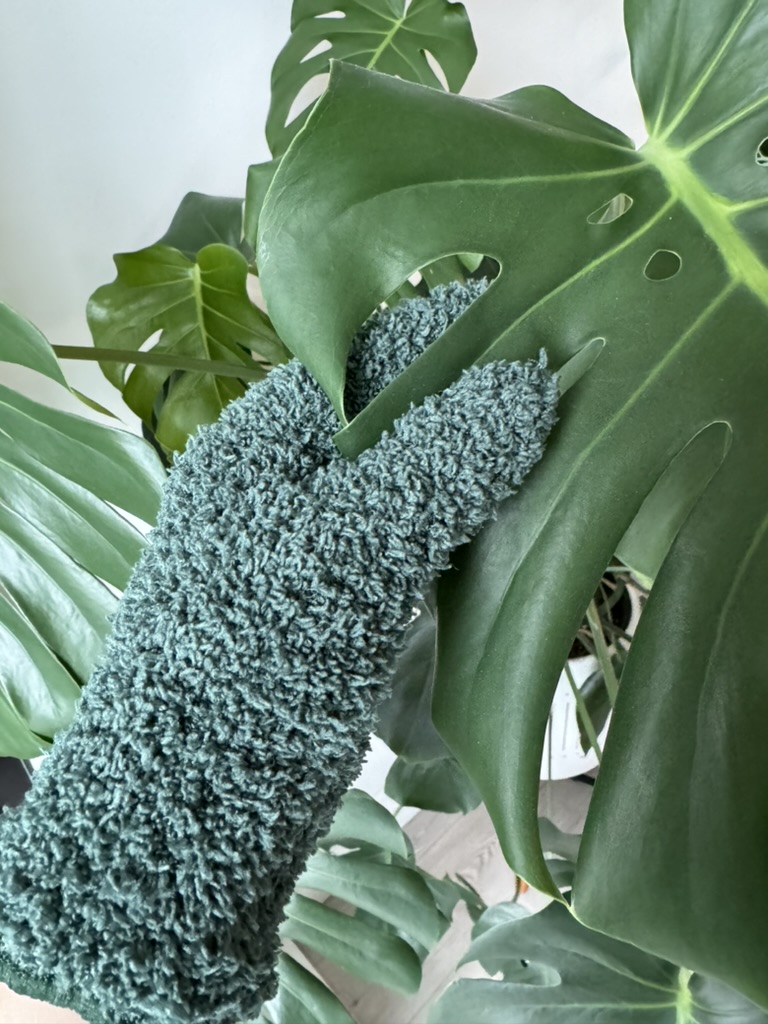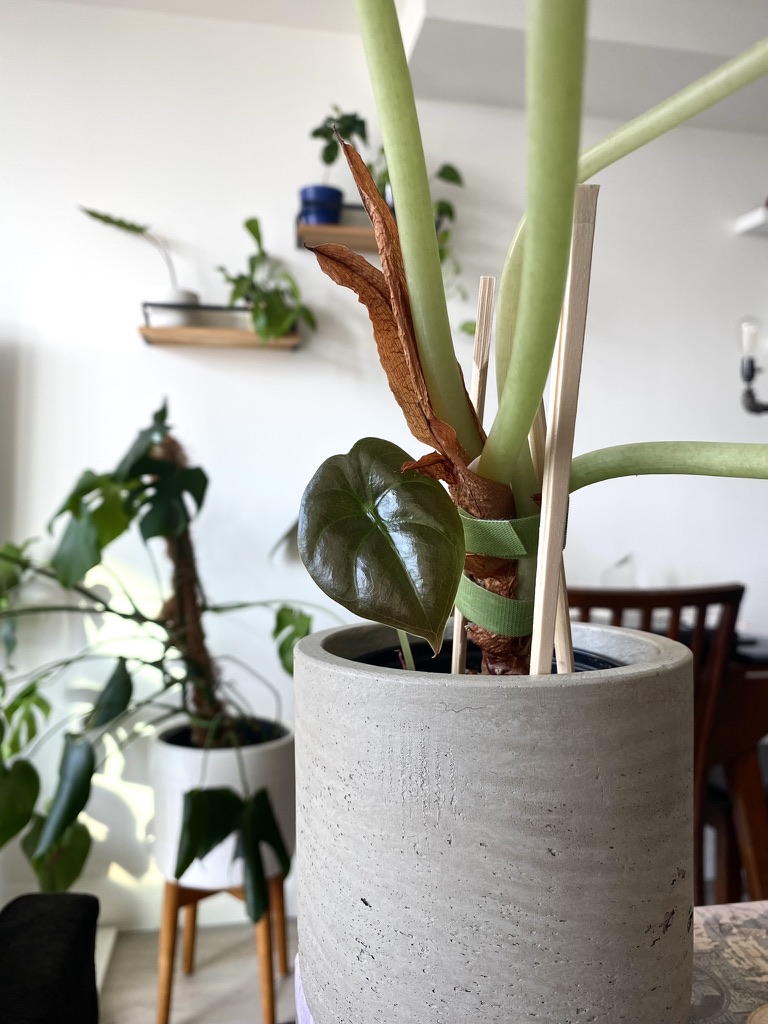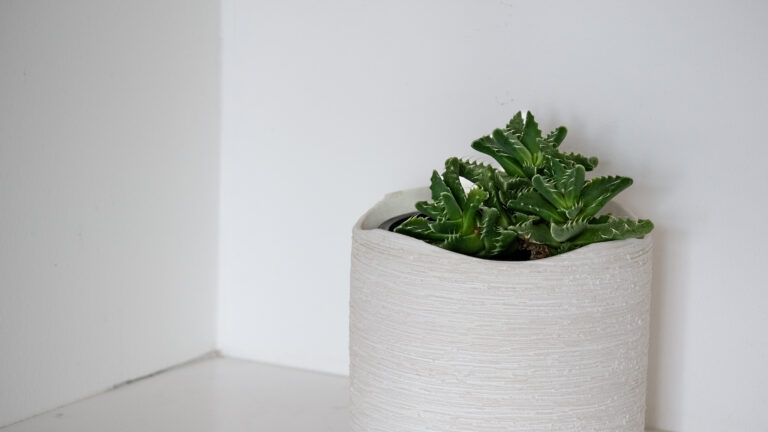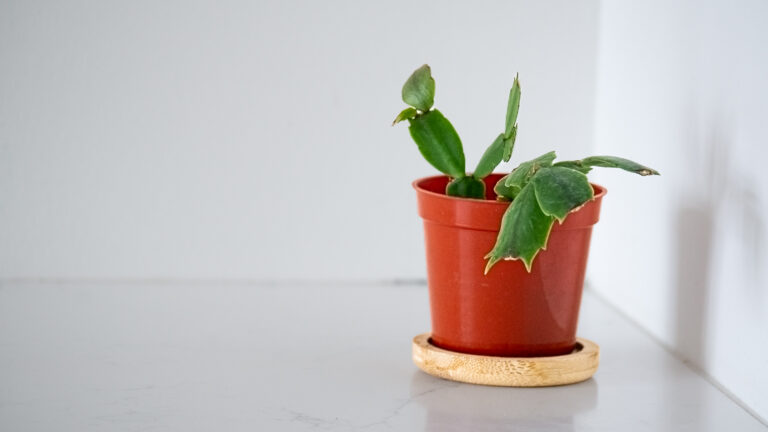Bunny Ear Cactus or Opuntia Microdasys is a member of the Cactaceae family. It is native to Central and Northern Mexico.
Opuntia Microdasys is referred to as the Bunny Ear Cactus because the pads grow in a way that resembles a bunny’s ears. The pads are covered with tiny spines that can look like fur.
For centuries, Opuntia have also been used for food, medicine, and as a source of water. They can also produce fruit, which are edible.
There are around 1,750 species of the Cactacae family.
🪴 Appearance of Bunny Ear Cactus
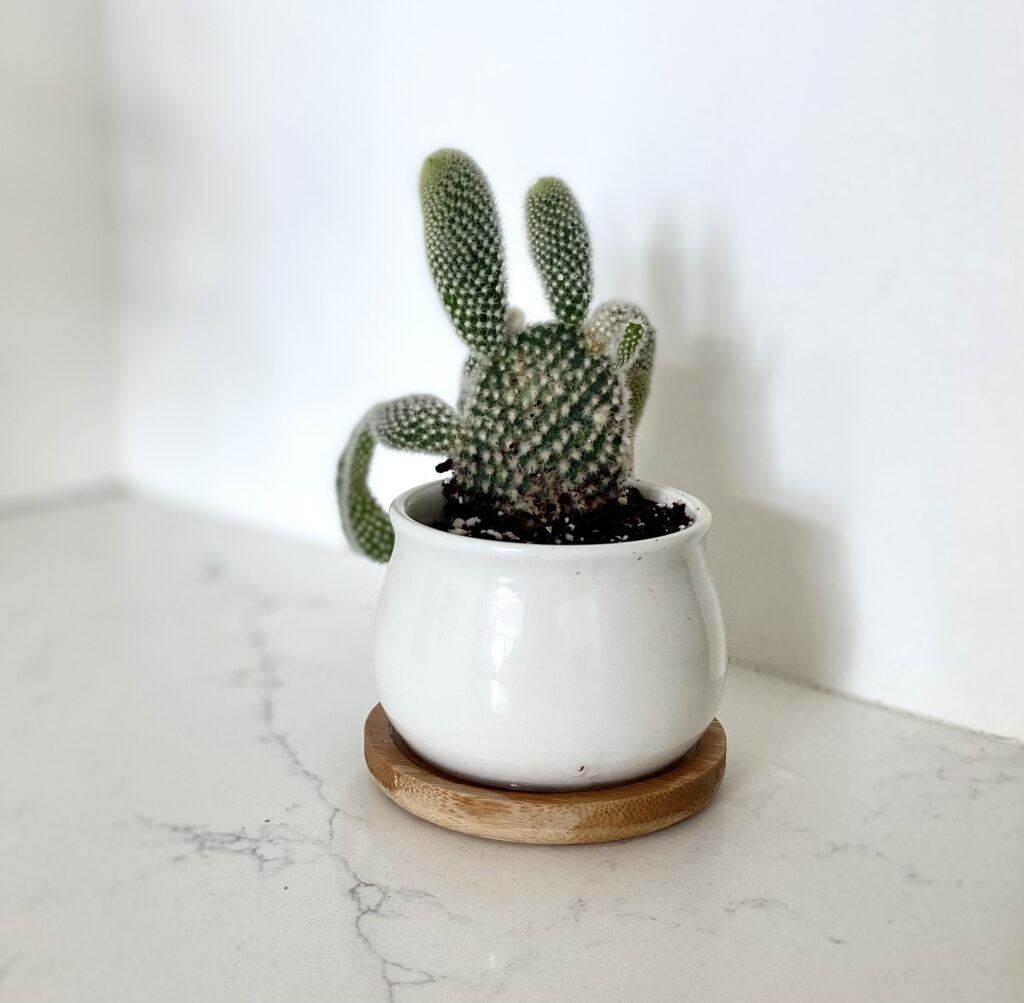
Bunny Ear Cactus are green with white spines all over. The plant grows pads in a stacked manner, which can resemble a bunny’s ear.
☀️ What Light Does Bunny Ear Cactus Need?
Bunny Ear Cactus thrives in a mixture of bright and indirect light. They like a few hours of sun in the morning with more indirect light in the afternoon.
If the plant does not get enough light, the pads will grow really long, and leggy, also known as etiolated (see image below).
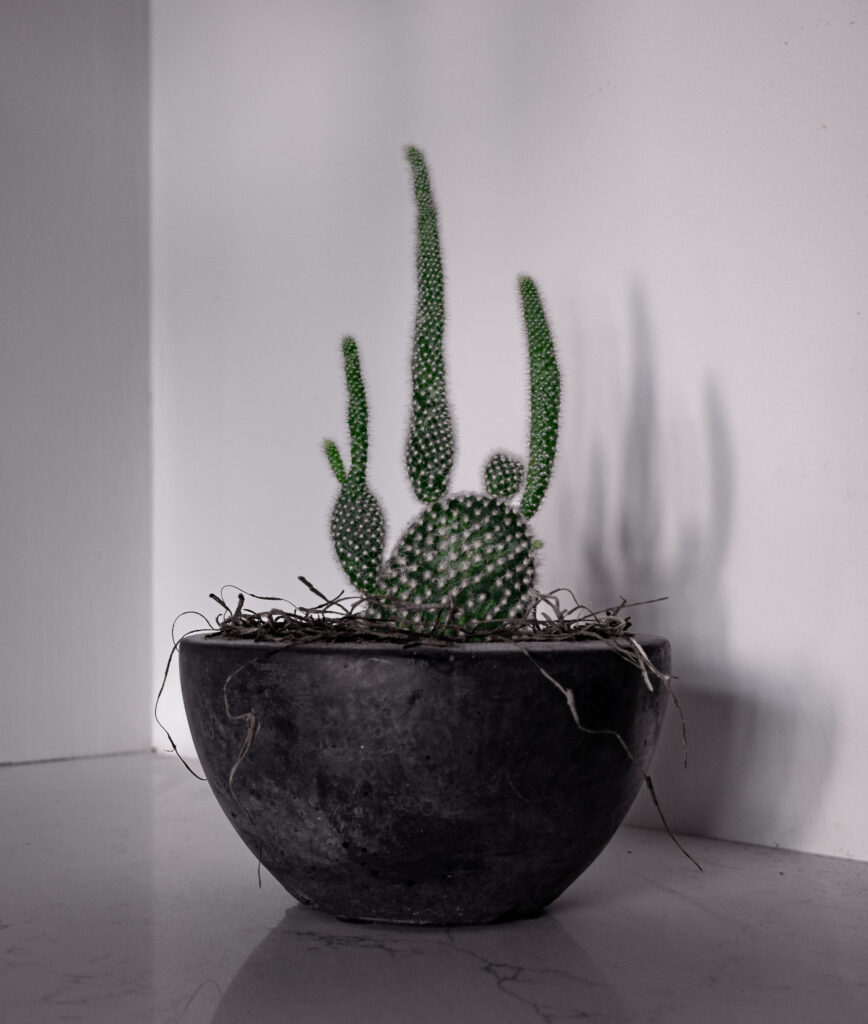
🌡️ What Temperature and Humidity does Bunny Ear Cactus Need? 🌫️
Bunny Ear Cactus prefers a temperature between 18-29 degrees celsius, but can tolerate 10-15 degrees celsius during the winter. They also prefer lower humidity. Since they come from arid regions, they prefer drier air, but do well in average household humidity levels (40-60%). You just don’t want to put it too close to your humidifier.
I keep my cactus closer to the window and further from the humidifier (I use the Levoit Hybrid Ultrasonic Humidifier (LV600HH)).
I use my humidifier to ensure the humidity levels in my apartment stays between 40% and 60%. Since I live in Canada and the winters can be very dry, and the humidity can drop below 30% humidity, so its helpful to set the humidity at about 45% or 50% in this season to keep all of my plants thriving.
🌱 How Does the Bunny Ear Cactus Grow?
On average, Bunny Ear Cactus can grow up to 2 feet.
New foliage appears to branch. While the Bunny Ear does grow taller, it mainly grows pads out of the central base in a clump formation.
Over time, the Bunny Ear Cactus pads will grow more horizontally, and produce additional clusters.
The growth pattern of the Bunny Ear Cactus is why its common name is the Bunny Ear Cactus.
🌸 Does the Bunny Ear Cactus Bloom?
This plant does in fact flower. Typically its flowering period is early spring or summer.
✂️ How to Propagate Bunny Ear Cactus?
The easiest way to start a new Bunny Ear Cactus is by taking a cutting.
- Choose a pad or segment from a healthy adult plant. Make the cut below the pad. Healthy, mature pads will have a higher likelihood of success.
- Wait for the cutting to callus over in a well lit spot. This should take a couple of days.
- Once the callus is formed, you can pot it into a well-draining potting mix, and roots should form.
- For best results, put the potted propagation in a location with bright, indirect light. Direct sunlight can be too stressful for the cutting.
- Roots can take from a few weeks to a couple of months. You can tell if roots are forming if you feel a bit of resistance after gently tugging on the potted cutting. For quicker rooting, some people use rooting hormone.
Patience is key with propagation. Give your new plant time to settle into its environment. Once you see new growth, you know your plant is well established.

💧 How Much Water Does the Bunny Ear Cactus Need?
The Bunny Ear Cactus likes to dry out between waterings. To determine if your plant needs water, you can stick your finger in the soil (1 to 2 inches) and if it is dry, its ready for water!
If you don’t want to get your hands dirty, you can try a moisture meter (I personally have not used one, but I know quite a few people who do, and this one is really highly rated on Amazon).
This plant typically needs to be watered every 4 weeks (depending on your environment).
I typically bottom water this plant through the drainage hole of the pot on a tray. It’s the easiest way to know if your plant is thirsty or not. Overwatering can lead to fungus gnats, root rot, or the death of your plant.
You can top water, but it’s best to do so in a pot with drainage until water is flowing out of the hole. If your pot doesn’t have drainage, you might accidentally drown your plant or make some fungus gnats very happy.
You should top water from time to time to make sure any built up minerals can wash through the plant. The water should drip out of the bottom of your drainage hole.
🪳 Pests & Problems 😔
Bunny Ear Cactus can face the following pests and problems.
🪳 Pests
- Mealy Bugs: these look like little white cotton balls on the plant. You can remove these with your fingers if you catch them early enough, but I would use a cotton swab with a drop of Isopropyl alcohol and try to scrape them off the stem.
- Scale: I’ve never personally had scale (knock on wood) and I am very thankful. Scale are small, brownish, round or oval insects that attach themselves to the leaves or stems of the plant. They are hard to notice as they appear like a growth or bump on the plant. Scale can cause yellowing, wilting, and weakened growth. Removing scale from a plant is tedious, like with mealybugs. You can remove scale by manually removing them with a cotton swab with rubbing alcohol, using insecticidal soap or horticultural oil.
- Aphids: Aphids are small, insects that cluster under leaves and stems. They can appear white, brown, black, gray, light green or yellow. If you see distortion, wilting or yellowing leaves, this can be a sign of aphids. You should be able to spray them off with a strong stream of water or using insecticidal soap.
- Spider Mites: If spider mites have taken to your plant, spray them with a mixture of neem oil, dish soap and water (or you can buy an insecticidal soap). You will know you have spider mites if you see webbing and leaf damage. Learn how to eradicate Spider Mites.
😔 Other Common Problems
- Overwatering: Root rot happens from overwatering your plant with insufficient drainage. You can improve the drainage of your plant by ensuring your plant is potted in a planter with a drainage hole and using a well draining soil (something with a decent amount of perlite). You can also end up with fungus gnats or fungal disease from overwatering.
- Underwatering: Even though cacti like to completely dry out between waterings, you still have to remember to water it on a consistent schedule. Signs of underwatering an aloe include leaves becoming shrivelled, discoloured or dry.
- Sunburn: Even though you will often find this plant in bright, sunny environments, they can be burned. Just like in humans plants can burn. Their leaves can start to turn red, yellow, white, bleached or sometimes kind of purple. To fix sunburn in the succulent you can move it to a less sunny place.
- Cold temperatures: Damage from cold temperatures can lead to vulnerability to disease, visible discolouration, growth stagnation or death. You can prevent this by making sure your Bunny Ear Cactus is not exposed to environments below the recommended temperatures.
- Etiolated: Being etiolated (or leggy) happens if the Bunny Ear Cactus doesn’t get enough sun. The pads will grow really long trying to reach the sun.
☢️ Is the Bunny Ear Cactus Toxic?
Bunny Ear Cactus are typically not toxic to touch or consume, however some people may experience allergic reactions.
Bunny Ear Cactus Quick Care Guide
| Scientific Name | Opuntia Microdasys |
| Nickname | Bunny Ear Cactus or Polka-Dot Cactus |
| Origins | Mexico |
| Light | Bright, direct (only for a couple hrs a day) and indirect, medium-light. |
| Temperature | 18-29 degrees celsius (preferred), 10-15 degrees celsius can be tolerate during the winter |
| Humidity | Low |
| Height | Up to 1-2 feet |
| Blooms | Yes, it can in spring or early summer |
| Propagate | Stem cuttings |
| Water Frequency | When dry (likely once a month) |
| Pests | Mealy Bugs, Aphids, Scale, Spider Mites |
| Common Problems | Overwatering (root rot), underwatering, fungal disease, sunburn, cold temperatures |
| Toxicity | Non-toxic |

